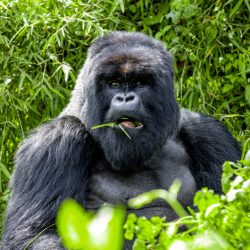Network of automatic weather stations established in mountain gorilla habitat
Blog | 31/01/11
During the last two months, I have been visiting different areas throughout the region to locate, in collaboration with park authorities, sites appropriate for the installation of automatic weather stations close to mountain gorilla habitat. When all is complete, 10 automatic weather stations will be established in the Virunga-Bwindi landscape.
This post is written by Dr. Augustin Basabose, Species Coordinator for the International Gorilla Conservation Programme and is based in Goma, Democratic Republic of Congo.
So far, six automatic weather stations have been installed in areas inhabited by mountain gorillas including:
- Two stations installed in Mikeno sector, PNVi-DRC (one in Jomba and one in Bukima rangers’ outposts).
- Two stations installed in PNV-Rwanda (one on the foot of Mont Karisimbi in Mutura area and one on the foot of Mont Sabinyo in Kinigi area).
- One station installed in Mgahinga Gorilla National Park – Uganda at Ntebeko on the foot of Mont Mgahinga
- One station in Sarambwe Natural Forest Reserve where two semi-habituated groups of mountain gorilla groups are frequently monitored by ICCN rangers.
At the Bukima ranger outpost, we were blessed by an uncommon visit of a group of gorillas (Rugendo family) who came out to the edge of the forest where we were busy installing an automatic weather station. The group came so close to us (approximately 25 meters as if they came to witness what was going on), stopping all their activity for more than 10 minutes before escaping in a nearby maize field for crop raiding. Good enough, a few HuGo (Human-Gorilla Conflict Resolution) members were around to repel the gorillas back into the forest.

Members of the Rugendo group visit the Bukima ranger post while the automatic weather station is being installed.
The purpose of establishing automatic weather station network close to mountain gorilla habitat is to assess the changes (differences) at micro-habitat level to better understand the impact of climate change (variability) on micro-habitat level and interpret the changes in behavioral ecology of mountain gorilla in relation to climate variation.
Until now, the lack of weather stations in the protected areas have restricted parks’ ability of climate related disaster prevention and reduction.
The newly established network of automatic weather stations is expected to provide accurate useful information on climate variability allowing protected areas authorities making policy decisions on climate related disaster prevention and reduction of climate change impact on park’s biodiversity and therefore promoting natural resource conservation and improving socio-economic development of human communities surrounding mountain gorilla parks.
It is anticipated that the use of automatic weather stations will ensure the standardization of network observations, both in time and quality.
So far, functionality of all the installed six automatic weather stations has been successfully tested with satisfaction from beneficiaries, the protected area authorities. The installed automatic weather stations are very easy to operate, recording climate data every 30 minute changes in the weather, and data are stored in the station’s data logger and kept for several months and can be later downloaded using a computer for analysis. The station is equipped with a solar panel for autonomous operation and has a console displaying a range of climate data and provides a daily bulletin forecasting weather conditions for the coming hours.

Dr. Basabose (left) works with Abel Musana with the Rwanda Development Board to test the weather station.
It is our hope that upon completion of the establishment of this network of weather stations close to mountain gorilla habitat in both Bwindi and Virunga ecosystems, climatic change will be forecasted and its negative impact on biodiversity, including the endangered mountain gorilla, mitigated substantially.
This is an activity which I will be heavily involved with on behalf of IGCP in coming years.
Purchase and installation of the weather stations made possible by the MacArthur Foundation.



